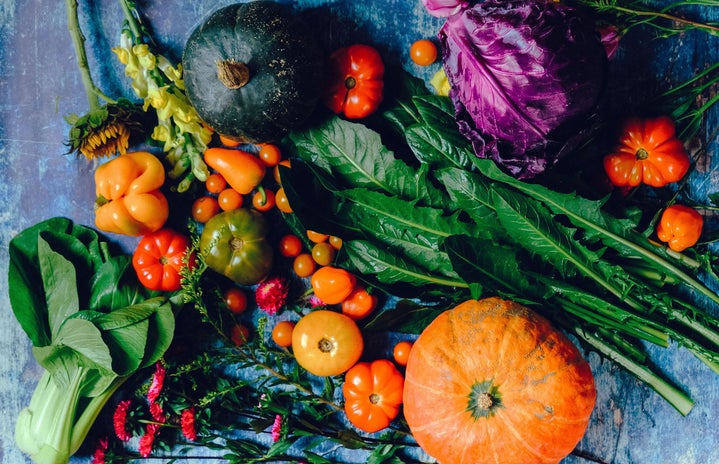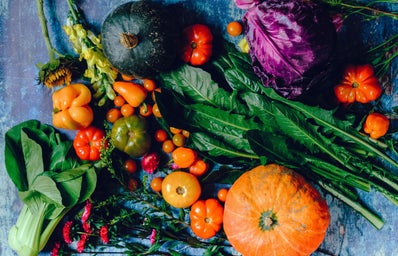People often assume that following a vegetarian diet is restrictive, but this couldn’t be further from the truth, especially if you’re Lebanese. Most Lebanese dishes don’t contain any meat, and for those that do, the meat component can easily be substituted with protein-rich legumes like chickpeas or lentils. If you’re a vegetarian struggling to find something new and exciting to make for dinner, or if you’re someone who’s simply trying to explore different cuisines, I’ve got two relatively simple Lebanese vegetarian recipes to help get you started.
- Mdardara + Cabbage and Beet Salad
-
Mdardara (also called mujadara in certain regions in the Middle East) is pretty simple to make, so it’s great for a student who doesn’t have much time to devote to cooking. This rice and lentil dish is filling and nutrient-rich. It’s convenient because it can be eaten hot or cold, so if you make it for lunch at school, you don’t have to worry about tracking down a microwave to heat it up. I like to pair my mdardara with a pickled cabbage and beet salad, but you can have it with whatever salad you would like on the side (fattoush could pair pretty well with it too). Mdardara is the nightmare of every Lebanese child (no kid will eat something that’s this good for them), but we all grow up to love and appreciate it.
What you’ll need: For the mdardara, you’ll need one cup and a half of lentils, one cup and a half of white rice, two big onions, one quarter cup of corn oil, two large spoons of salt. For the side salad, you’ll need: cabbage, boiled beets, vegetable oil, red vinegar, and salt to taste.
Serves: A family of 6 very hungry people, as well as a few cousins that show up uninvited on your doorstep in typical Lebanese fashion.
Steps:
1) Wash lentils in a strainer and let them dry. Put them in a pot once dried.
2) For each cup of lentils or rice, use 2 cups of water. So, this recipe requires 6 cups of water. Put the water for both the rice and lentils in the pot at once.
3) Boil the lentils until they’re somewhat soft. This usually takes 20 minutes on medium heat. After the lentils soften, add rice to the pot. Then, add two spoons of salt. .
4) Chop up onions in large strips. Put ¼ cup of corn oil in a pan and cook the onions until brown. Put the onions aside and pour the leftover oil in the pot of lentils and rice.
5) As the rice cooks, gradually lower the heat.
6) Turn off the heat and cover the pot. Leave for 10 minutes for the rice to puff up.
7) When it’s time to serve, put the rice and lentils on a plate and put the onions on top.
8) For the side salad, cut up desired amounts of cabbage into thin strips and boiled beets into cubes. Add vinegar, vegetable oil, and salt to taste. You can leave the mix in the fridge to pickle over a few hours, but this is optional.
- Loubieh B’zeit
-
This second dish, called loubieh b’zeit, is another one of my all-time favorites, although it does take a bit more preparation, skill, and time to make than mdardara. Loubieh b’zeit simply translates as beans in oil (green beans, that is). It is packed with flavor, mostly due to the addition of bharat, an eight-spice mixture that is characteristic of Middle Easten cuisine. You can make this spice at home by mixing together equal parts of: black pepper, coriander, paprika, cardamom, nutmeg, cumin, cloves, and cinnamon. Alternatively, you could buy bharat directly from any local Middle Eastern grocer. Typically, loubieh b’zeit is eaten by scooping it up into wedges of pita bread, but I prefer to have it with plain rice or bulgur cooked in tomato paste.
What you’ll need: 3 pounds of green beans, 5 large tomatoes, one head of garlic, one large onion, half a cup of corn oil, two large spoons of salt, one teaspoon of pepper, half a teaspoon of bharat, two large spoons of tomato paste.
Serves: A family of 6 hungry people, and the same cousins that aren’t getting the message to leave your damn house.
Steps:
1) Cut green beans in half and chop off the ends. Wash and leave them in a bowl of water.
2) Put the oil and cloves of garlic in a pot. Heat at medium heat and mix. Don’t let them turn brown.
3) Add small, cubed onions into the pot after about 5 minutes. Mix until the onions have melted or wilted.
4) Add the beans to the pot while still wet. Add a cup of water to the pot as well.
5) Cover the pot. Do not mix with a spoon, instead shake the pot vigorously every few minutes.
6) Add the two spoons of salt.
7) Once the beans are somewhat soft, add cubed tomatoes to the pot. Cover up the pot again and shake every few minutes.
8) Once the tomatoes have wilted, add two spoons of tomato paste.
9) Fill the pot with water up to where the beans reach.
10) Leave on medium heat and wait until the beans are soft.
11) Before taking the pot off the stove, add bharat.
I hope you’ve enjoyed learning about these classic Lebanese dishes. Let us know if you decide to try these recipes out, and keep your eyes peeled for the second part of this little series, where I will share how I make fattoush, the well-known Lebanese salad, and foul, a fava bean dish.



